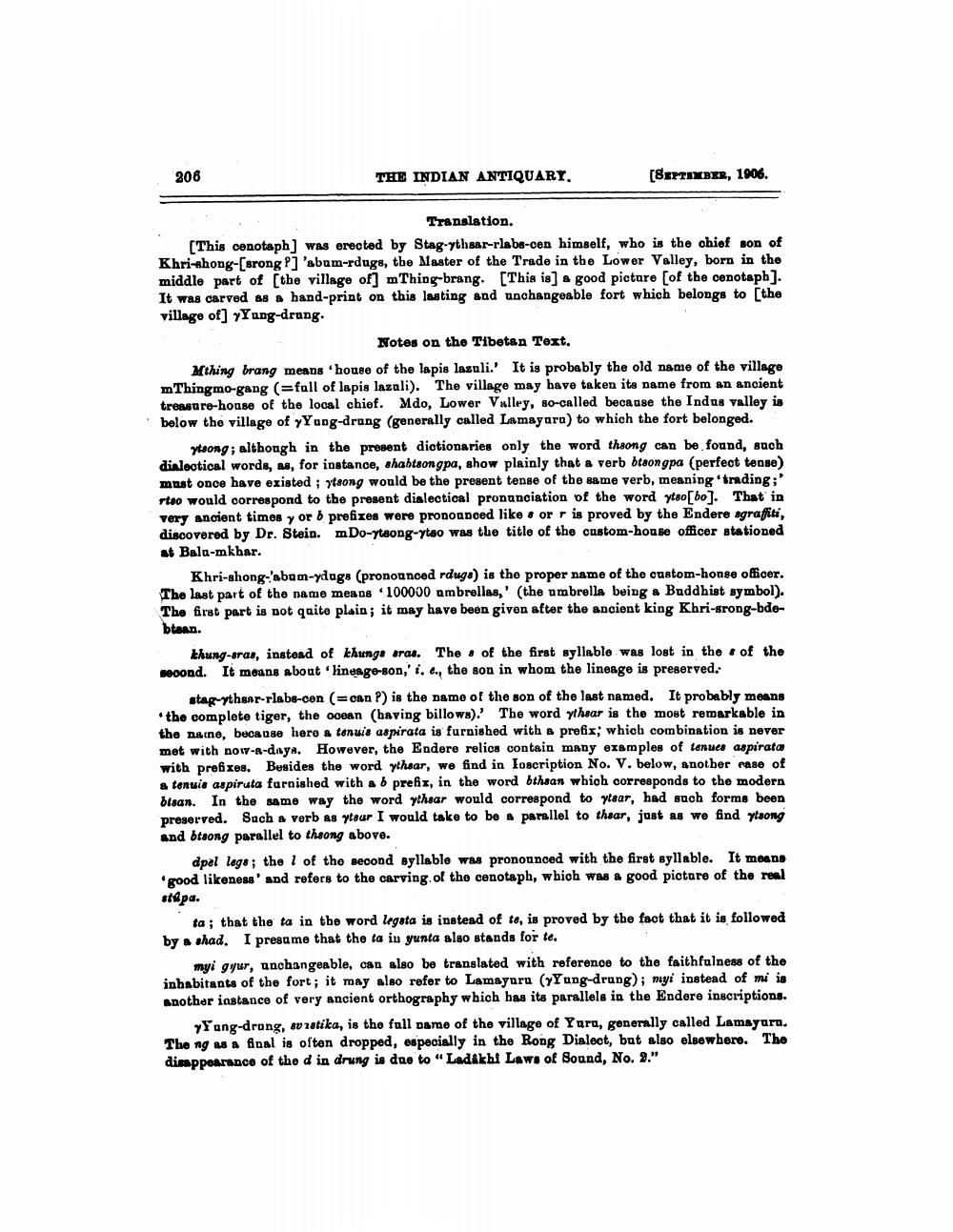________________
206
THE INDIAN ANTIQUARI.
[SEPTEMBER, 1906.
Translation. (This cenotaph) was erected by Stag-ythsar-rlabs-cen himself, who is the chief son of Khri-thong-(srong P] 'abum-rdags, the Master of the Trade in the Lower Valley, born in the middle part of the village of] m Thing-brang. [This is] a good picture of the cenotaph]. It was carved as a hand-print on this lasting and unchangeable fort which belongs to (the village of] yYang-drang.
Notes on the Tibetan Text. Mthing brang means "house of the lapis lazuli.' It is probably the old name of the village m Thingmo-gang (=fall of lapis lazuli). The village may have taken its name from an ancient treasure-house of the local chief. Mdo, Lower Valley, so-called because the Indus valley is below the village of yYung-drang (generally called Lamayaro) to which the fort belonged.
yoong; although in the present dictionaries only the word thaong can be found, such dialectical words, ae, for instance, shabtaongpa, show plainly that a verb btaongpa (perfect tense) must once have existed; ytaong would be the present tense of the same verb, meaning trading: rtoo would correspond to the present dialectical pronunciation of the word ytao[bo]. That in very ancient times y or b prefixes were pronounced like a or r is proved by the Endere agrafiti, discovered by Dr. Stein. mDo-ytaong-yeo was the title of the custom-house officer stationed at Bala-mkbar.
Khri-shong-abam-ydag* (pronounced rugs) is the proper name of the custom-honse officer. The last part of the name means 100000 ambrellas,' (the umbrella being a Buddhist symbol). The first part is not quite plain; it may have been given after the ancient king Khri-srong-bdebtean.
khung-sras, instead of khunge sras. Thes of the first syllable was lost in the of the second. It means about lineage-son,' i, e., the son in whom the lineage is preserved.
stag-ythgar-rlabs-cen (=can P) is the name of the son of the last named. It probably means the complete tiger, the ocean (having billows).' The word ythear is the most remarkable in the name, because hero a tenuis aspirata is furnished with a prefix, which combination is never met with non-a-daya. However, the Endere relics contain many examples of tenues aspirata with prefixes. Besides the word ythear, we find in Ioscription No. V. below, another case of a tonuis aspiruta furnished with a b prefix, in the word bthaan which corresponds to the modern bisan. In the same way the word ythsar would correspond to ytsar, had such forms been preserved. Such a vorb as your I would take to be a parallel to thaar, just as we find ytaong and btaong parallel to thaong above.
dpel legs; the l of the second syllable was pronounced with the first syllable. It means 'good likeness and refers to the carving of the cenotaph, which was a good pictare of the real stepa.
ta; that the ta in the word legata is instead of to, is proved by the fact that it is followed by a shad. I presume that the ta iu yunta also stands for te.
myi gyur, anchangeable, can also be translated with reference to the faithfulness of the inhabitants of the fort; it may also refer to Lamayuru (YYang-drung); myi instead of mi is another instance of very ancient orthography which has its parallels in the Endere inscriptions.
yang-drong, so zatika, is the fall dame of the village of Yara, generally called Lamayura, Tho ng as a final is often dropped, especially in the Rong Dialect, but also elsewhere. The dimappearance of the d in drung is due to “Ladakhi Laws of Sound, No. 2."




